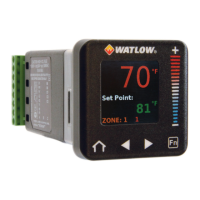Watlow PM PLUS™ 6 • 103 • Chapter 8: Features
CIP Communications: DeviceNet or EtherNet/IP
Common Industrial Protocol (CIP) is used to collect data, configure, and control the PM PLUS. CIP is an
open protocol at the application layer fully managed by the Open DeviceNet Vendors Association (ODVA,
http://www.odva.org). EtherNet/IP and DeviceNet use the same addressing scheme. EtherNet/IP is a network
communication standard capable of handling large amounts of data at speeds of 10 Mbps or 100 Mbps, and
at up to 1,500 bytes per packet. It makes use of standard off-the-shelf Ethernet chip sets and the currently
installed physical media (hardware connections). DeviceNet can communicate at 125, 250 and 500 kilobytes
per second with a maximum limitation of 64 nodes (0 to 63) on the network.
For implicit communications (real time I/O messaging) using a PLC, configure the PM PLUS™ assembly size
into the I/O structure of the PLC (See: CIP Implicit Assemblies Structures). The assembly structures can be
changed.
For explicit communications (information/configuration messaging), you'll need to use specific addressing
information. DeviceNet requires the node address; EtherNet/IP requires the Class, Instance and Attribute.
• Node address or MAC ID (0 - 63, DeviceNet only)
• Class ID (1 to 255)
• Instance ID (0 to 255)
• Attribute ID (1 to 255)
The PM PLUS™ does not support connected explicit messages but fully supports unconnected explicit
messaging.
NOTE: The maximum number of implicit input/output members using DeviceNet is 40. When using
EtherNet/IP the maximum is 40.
CIP Implicit Assemblies
PM PLUS™ may be purchased with DeviceNet or EtherNet/IP communications cards. Reading or writing
when using CIP is accomplished via explicit and or implicit communications. Explicit communications are
usually executed via a message instruction within the PLC but there are other ways to do this as well outside
of the focus of this document.
Implicit communications is also commonly referred to as polled communications. When using implicit com-
munications there is an I/O assembly that would be read or written to. The default assemblies and the as-
sembly size is embedded into the firmware of the PM control. Watlow refers to these assemblies as the
T to O (Target to Originator) and the O to T (Originator to Target) assemblies where the Target is always the
controller and the Originator is the PLC or master on the network. The size of the O to T assembly is ini-
tially set to 40 (32-bit) members where the T to O assembly consists of 40 (32-bit) members. All assembly
members are user configurable with the exception of the first T to O member. The first member of the T to
O assembly is called the Device Status, it is unique and cannot be changed. If the module has been properly
configured when viewing this 32-bit member in binary format bits 12 and 16 should always be set to 1 where
all of the other bits should be 0. All other members that follow Device Status are user
configurable.
If the control is brought back to the factory default CIP Implicit Assembly Structures the user
configured assemblies will be overwritten.

